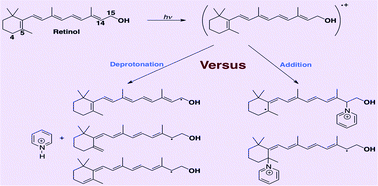Laser flash photolysis study on the retinol radical cation in polar solvents†
Abstract

* Corresponding authors
a
Department of Material and Life Science, Graduate School of Engineering, Osaka University, ALCA, Japan Science and Technology Agency (JST), Suita, Osaka, Japan
E-mail:
a_el_agamey@yahoo.co.uk, fukuzumi@chem.eng.osaka-u.ac.jp
Fax: +81-0668797370
Tel: +81-0668797369
b Chemistry Department, Faculty of Science, Mansoura University, New Damietta, Damietta, Egypt
c Department of Bioinspired Science, Ewha Womans University, Seoul, Korea

 Please wait while we load your content...
Something went wrong. Try again?
Please wait while we load your content...
Something went wrong. Try again?
A. El-Agamey and S. Fukuzumi, Org. Biomol. Chem., 2011, 9, 6437 DOI: 10.1039/C1OB05814B
To request permission to reproduce material from this article, please go to the Copyright Clearance Center request page.
If you are an author contributing to an RSC publication, you do not need to request permission provided correct acknowledgement is given.
If you are the author of this article, you do not need to request permission to reproduce figures and diagrams provided correct acknowledgement is given. If you want to reproduce the whole article in a third-party publication (excluding your thesis/dissertation for which permission is not required) please go to the Copyright Clearance Center request page.
Read more about how to correctly acknowledge RSC content.
 Fetching data from CrossRef.
Fetching data from CrossRef.
This may take some time to load.
Loading related content
